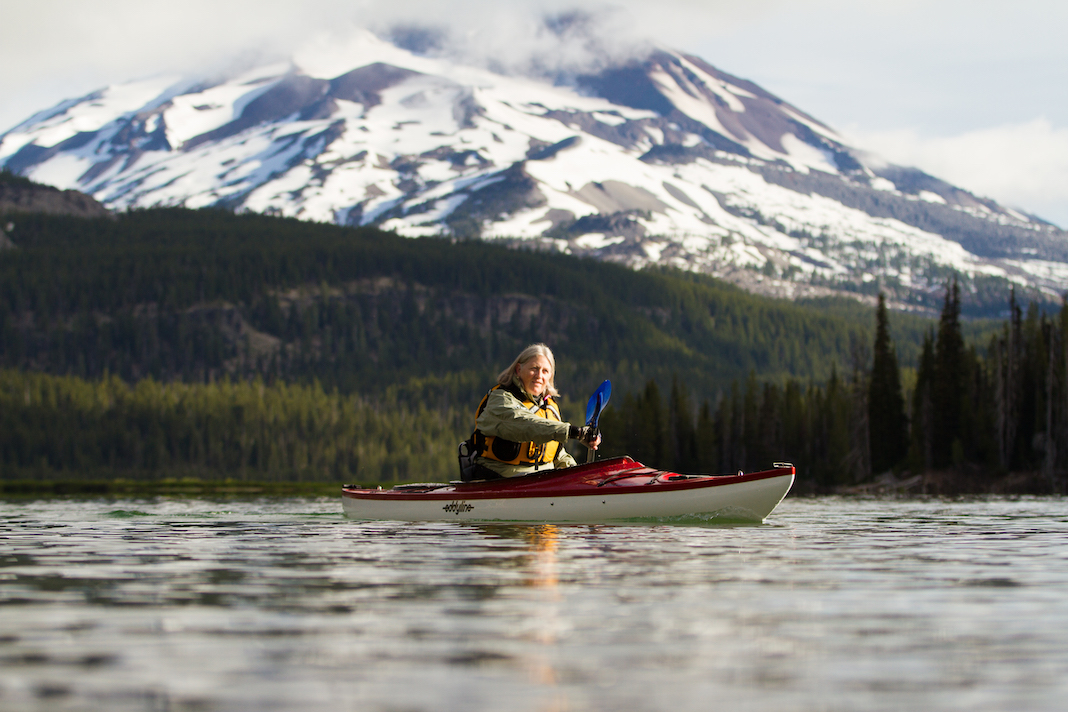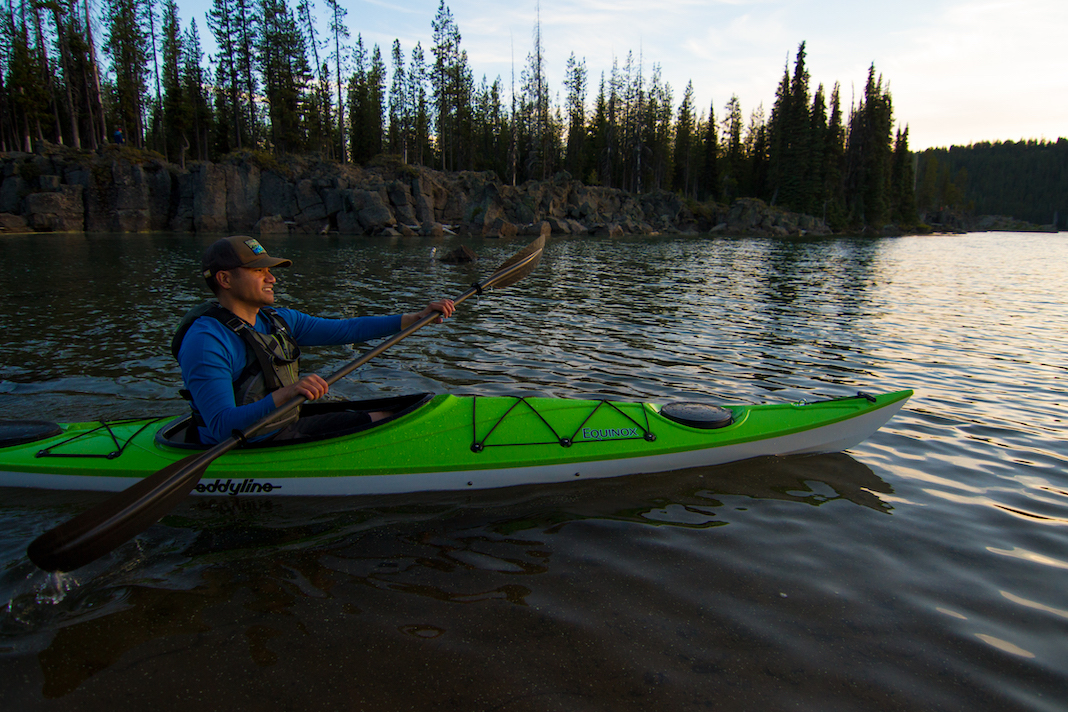Founded in 1971, Eddyline was one of the first commercial kayak builders in North America, first with whitewater boats and then with high-volume sea kayaks for West Coast adventures. Today, you’ll find Eddylines all around the continent. With their candy colors and glossy finishes, Eddyline kayaks are hard to miss. They are still made in the U.S. at Eddyline’s production facility in Burlington, Washington.
Today, Eddyline has adapted their expertise in building whitewater and sea kayaks to expand their lineup to include recreational, sit-on-top and fishing kayaks as well. The common feature across all these categories is that every one of Eddyline’s lightweight, nimble kayaks is made from thermoformed plastic.
If you are looking for a high-end kayak that is easy to carry and responsive on the water, consider an Eddyline. New paddlers will appreciate the intuitive handling of the boats, while experienced kayakers will recognize the carefully crafted designs.
Eddyline’s range of kayaks include models suitable for everything from day trips on calm waters to weeklong expeditions on exposed coastlines. Traditionally, recreational and sit-on-top kayaks are made with the least expensive materials available, often resulting in a heavier, but durable kayak with bare-bones outfitting.
Thermoforming allows kayaks to be made that retain the durability, but shave off the weight. Lighter kayaks are easier to carry and load onto a vehicle/trailer. Eddyline also takes elements from their more advanced touring boats, like bulkheads, and incorporates them into their entry-level models.
In this guide, we provide an overview of Eddyline’s lineup, along with some buying advice and links to more reviews and information on specific kayaks.
Top picks: Best Eddyline kayaks for 2025
The following Eddyline kayaks have received the highest star ratings by reviewers in our Paddling Buyer’s Guide.
Best Eddyline Kayaks
Shopping for a used Eddyline kayak?
Choosing to buy used means you can get a quality kayak for less. The challenging part is knowing where to look, what to look for, and what is a fair price.
Where to look
Eddyline kayaks are sold across North America, so there’s a good chance one will turn up in your area. If you are specifically looking for an Eddyline kayak, Craigslist, Facebook Marketplace or Kijiji search terms can help filter other kayaks you aren’t interested in. Consider setting up an email alert to be notified when one is posted.
Visit a nearby Eddyline dealer and see if they have any demo kayaks or floor models for sale. If paddling events like symposiums are being held, dealers will bring boats for test-paddling. These boats are often for sale, and you may be able to get some reductions off the sticker price while being able to not only try the kayak, but also talk to an expert.
What to look for
When viewing a used kayak, give it a thorough inspection, paying special attention to the condition of the deck (top) and hull (bottom). Eddyline kayaks are finished with a UV- and abrasion-resistant coating that will protect the boat from most impacts. Minor scratches are okay, but major drops or abuse can result in cracking. In this case, repairs may need to be done.
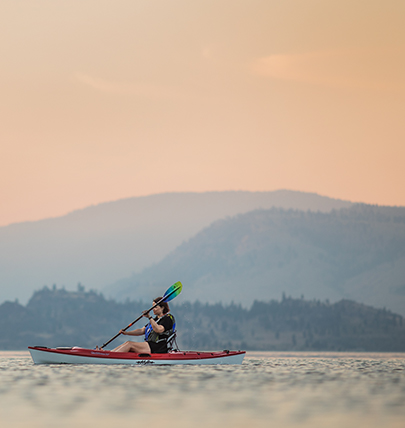
Eddyline sells a Carbonlite repair kit that can be used for all of their thermoform kayaks, and the repair process is relatively simple. If the kayak has a skeg or rudder, check that it deploys smoothly. Also check the function and condition of all outfitting, such as the seat, back rest and foot braces or pedals. If any replacement parts are needed, they can be ordered through Eddyline’s website.
How the kayak was stored is a good indicator of the condition it may be in. If the boat was kept in a garage, it will have less UV and moisture damage than one that was left sitting on a lawn. Some prolonged UV damage can be seen—look for fading or discoloration. If you can’t see any, it doesn’t hurt to ask the owner how they’ve stored the kayak.
Excessive UV damage may mean the kayak hull needs to be refinished. This is a bigger job, but one that a professional can do. Moisture damage is often indicated by mildew inside the kayak, stick your head inside the cockpit and hatches and shine a light to check.
What’s a fair price?
It’s difficult to gauge a fair price for used kayaks, especially as supply has not quite caught up with the increased demand for paddling gear that’s happening now. This may drive the prices of used kayaks higher than expected. Still, don’t forget that you get what you pay for. If a deal seems too good to be true, it likely is.
Kayaks hold their value well, especially if they have been cared for. That being said, a used Eddyline listed at its original sticker price is too expensive. A five-year-old kayak will lose about half of its original value, putting a fair price at 50% of the MSRP, but will not lose much more if it is in good condition.
For more tips on what to look for when selecting a used kayak, read our article How To Buy A Used Kayak.
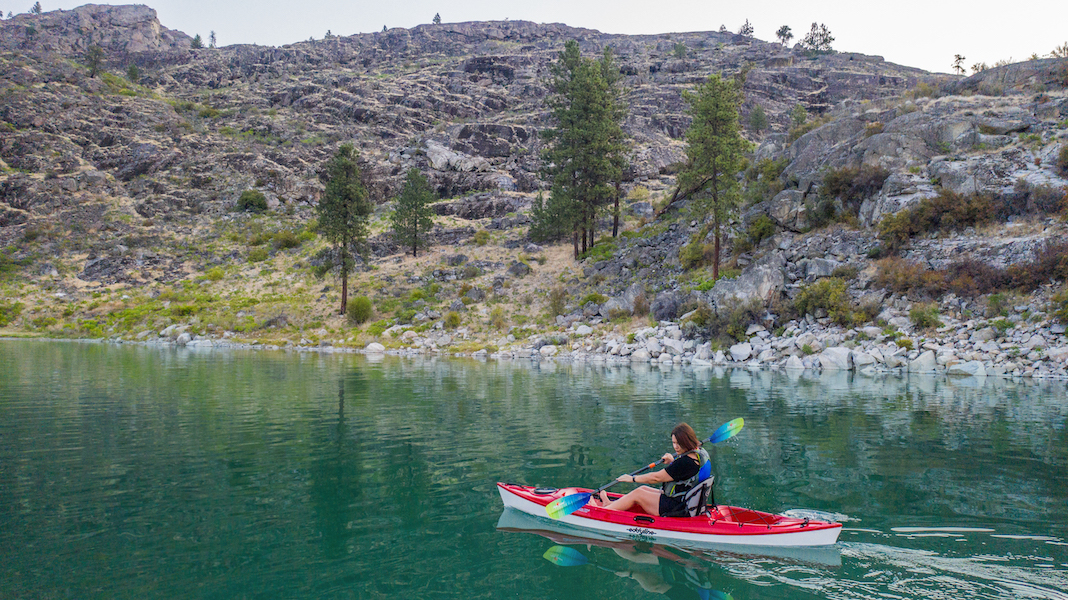
Eddyline Kayaks buying advice
Eddyline focuses on making light kayaks that are easy to maneuver and transport. Most of the boats they make are 14 feet or less. Eddyline divides their kayak catalog into four categories: Sit-on-top, Fishing, Recreational and Touring.
Sit-on-top
Sit-on-top kayaks include the Eddyline Caribbean in 12- and 14-foot lengths. Although the 12-foot kayak can accommodate a wide range of users, the 14-foot kayak adds speed and load capacity. The Caribbean 14 accommodates up to 325 lbs of weight compared to the Caribbean 12’s capacity of 275 lbs. There is also an option for the “FS” version, which comes with a deluxe frame seat (FS). The seat is removable and doubles as a beach chair.
Sit-on-tops are best suited to warm environments and are perfect for beginner kayakers who plan to explore calm, sheltered waters. With no cockpit to lower into, they are easy to enter and exit and feel less confining than a sit-inside kayak. While Eddyline sit-on-tops are very stable and easy to use, they offer less protection from the elements (sun, rain, cold) than a sit-inside design.
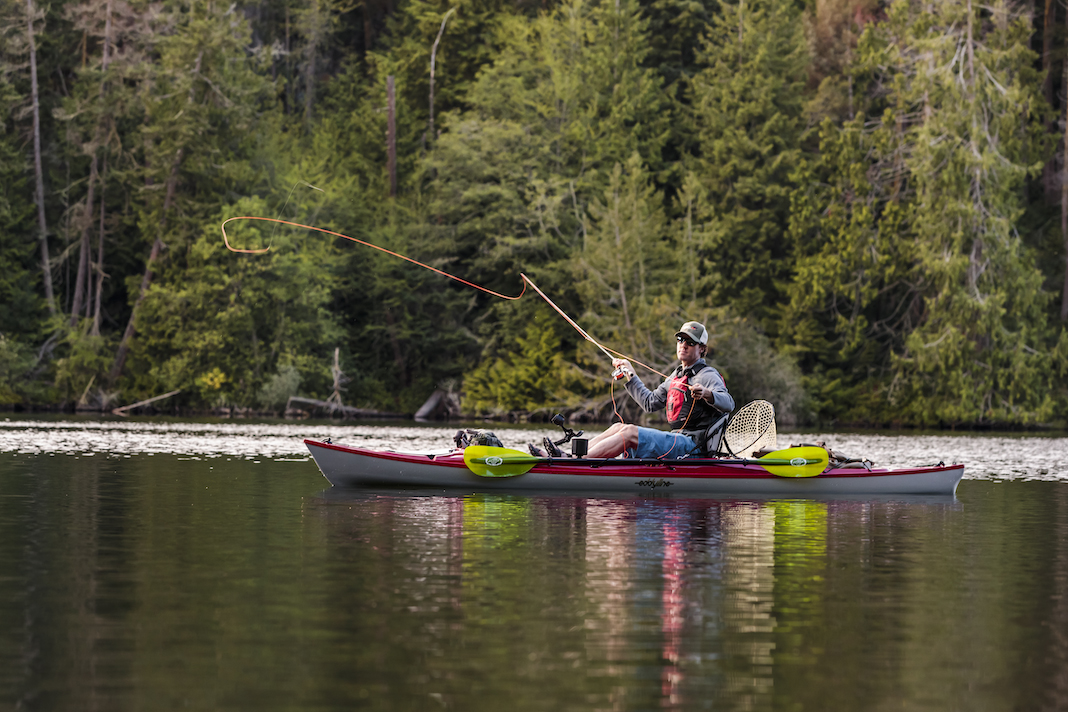
Fishing
Fishing kayaks from Eddyline are modified versions of the Caribbean sit-on-top models with tweaks for anglers. These include integrated rod holders and grip pads in the footwells. Sit-on-top kayaks are a favorite for anglers, as they are stable, easy to enter and responsive to paddle. Having an open deck is also great for accessing and storing gear like tackle boxes and fishing crates.
Eddyline’s fishing kayaks stand apart with their lightweight construction; as well as looking great with their glossy finish, these boats are easy to transport and carry solo.
Recreational
Eddyline offers six recreational kayaks in their catalog. Recreational kayaks bridge the performance of a touring kayak with the stability and responsiveness of a sit-on-top. Eddyline’s recreational kayaks are “sit-in” style, which gives additional control as the paddler’s legs engage with the kayak. Their recreational lineup ranges from 10- to 14-foot lengths.
The longer kayaks are geared towards paddlers who want to cover more distance on the water on day outings. This lineup includes best-sellers like the Skylark, which is an ideal boat for newer kayakers who want something they can turn easily when exploring calm waters.
All of Eddyline’s recreational kayaks are equipped with the storage and safety features of their larger touring kayaks, including hatches and watertight bulkheads.
Touring
Touring kayaks are the longest kayaks made by Eddyline. They are designed for adventurous paddlers who want to paddle in advanced conditions or take multi-day trips. They are at home in exposed coastal environments or choppy conditions. These kayaks are longer and narrower than the other Eddyline boats, making them more efficient to paddle. All of these touring kayaks feature a snug cockpit for additional boat control, and a comfortable seating system for long days in the saddle.
The touring category includes three iterations of the Sitka day-tourer for all different sizes of paddlers (XT, LT, ST); the flagship Fathom, Eddyline’s longest solo kayak, designed for extended wilderness trips; and the tandem Whisper, for paddling pairs who want to get out for day-long or multi-day trips.
All of Eddyline’s single person touring kayaks use a skeg for controlling the kayak as opposed to a rudder. The skeg is a retractable fin that drops into the water under the stern (back) of the kayak, helping it to stay on course (called “tracking”) when there is wind and waves pushing the kayak otherwise.
A rudder aids with both tracking and steering—a necessity on long tandem kayaks like the Whisper—but Eddyline solo kayaks turn easily enough that rudders aren’t needed.
Just like any kayak you are considering, it is crucial to “try before you buy.” Head to your nearest Eddyline dealer and chat with one of the staff there—they know boats. Describe your paddling goals, and take the kayak out for a spin to make sure it fits and performs as expected.
Still wondering if Eddyline kayaks are right for you? Here are answers to some of the most common online questions about Eddyline kayaks.
-
Are Eddyline kayaks good?
Eddyline kayaks are a good choice for anyone who is looking for an attractive and lightweight sit-on-top, fishing, touring or recreational kayak at a fair price. Depending on your paddling style, Eddyline offers kayaks for sheltered waters, day touring, fishing and longer paddles on more exposed waters. They come in a range of sizes and colors to suit everyone. The best way to know if an Eddyline kayak is a good fit for you is to try it out.
-
What are Eddyline kayaks made of?
Eddyline kayaks are made of their proprietary “Carbonlite” material, developed from ABS plastic. Carbonlite sheets are heated and vacuum-formed into the kayak mold. An outer layer of abrasion- and UV-resistant acrylic material is applied to the hull. The result is a kayak that is more impact-proof than premium fiberglass kayaks, but lighter than the rotomolded plastic models that are common amongst recreational and fishing kayaks.
-
Where are Eddyline kayaks manufactured?
Eddyline kayaks are made in Burlington, Washington.
-
Eddyline kayak durability
Eddyline kayaks are very durable due to the thermoforming process and impact-resistant materials used in the construction. Eddyline’s proprietary “Carbonlite” ABS material is applied in two layers for added strength, and then coated with an acrylic exterior to protect from abrasions and UV damage.
Nothing is indestructible, however, and it is possible to damage an Eddyline kayak in extreme circumstances. Thermoform plastic is more susceptible to cracking and shattering than rotomolded polyethylene, especially in very cold temperatures. Damage is most likely to result from a direct impact, such as a fall from a roof rack onto a sharp rock. If the hull does have a crack in it, the material can be repaired relatively easily by applying epoxy and a woven patch.
-
Eddyline kayak prices
Eddyline kayak prices range between $1,200 and $3,250 depending on the make and model of the kayak. Compared to other kayak brands, Eddylines land in the mid-range. They are more expensive than entry-level polyethylene kayaks, but cost less than space-age, ultralight composite kayaks.
-
Eddyline kayak dealers
Wondering where to buy Eddyline kayaks? Use the dealer locator tool to find one near you. At outdoor chains like REI, Eddyline kayaks and accessories may be available, although they are not listed on the site. Check your local store or inquire about special ordering a kayak. This is essentially placing an order through REI to have a kayak shipped.
-
How to store Eddyline kayaks
Storing Eddyline kayaks properly is key to ensuring they have a long life. Although the hull is UV-resistant, it is best to keep your kayak out of direct sunlight, ideally in a garage. If you need to store it outside, place the kayak under an awning to minimize sun damage.
Keep the kayak off the ground to prevent moisture damage and reduce the chances of critters making it their home. Make sure that the contact points of the rack do not warp the kayak. It’s ideal to place these near the bulkheads, using webbing or wide straps to minimize pressure points.
After paddling, rinse the kayak with freshwater to clear any sand, debris or salt, especially around the skeg and inside the cockpit. Make sure the kayak is completely dry before storing it.
Check out some creative storage solutions for your Eddyline kayak.
-
How to transport Eddyline kayaks
Kayakers can opt for either a roof rack or trailer when getting their boat to the put-in, and there are benefits to both, depending on the vehicle you drive. Smaller boats may fit into the bed of a pickup truck, but it isn’t ideal for anything longer than 10 feet.
Transporting your Eddyline kayak can be stressful. Serious damage can occur if the kayak is not secured properly. You’ll want four points of contact connecting the boat to the vehicle. Attach lines from your vehicle to the bow and stern for added safety and peace of mind.
A common mistake when securing the kayak is over-tightening the straps. This puts undue pressure on the kayak and can lead to cracks in the hull or deck. Avoid ratchet straps, and instead use cam straps to safely secure the kayak to your roof rack.
-
What is the lightest Eddyline kayak?
The lightest Eddyline kayak is the Sky 10 recreational kayak, weighing 32 lbs / 14.5 kg. All of Eddyline’s kayaks are built with lightweight materials and will be some of the lightest boats when compared to similar models from other brands.
Compare Eddyline kayaks
-
Eddyline vs Delta kayaks
Like Eddyline, Delta kayaks are made exclusively from thermoformed plastic. Where Eddyline kayaks are manufactured in Burlington, Washington, Delta builds their boats near Vancouver, British Columbia. Delta focuses more on touring kayaks, although they also make quality recreational kayaks. Both companies are excellent options for lightweight day touring kayaks. Go with Eddyline if you are looking for a sit-on-top or fishing-specific kayak.
-
Hurricane vs Eddyline
Hurricane kayaks are also high-quality thermoformed kayaks. They feature a more extensive line of sit-on-top kayaks than Eddyline. Look to Hurricane kayaks if you are set on a sit-on-top; Eddyline kayaks are designed more for touring, as evidenced by comfort-focused outfitting and skegs for superior tracking.
-
Eddyline vs Wilderness Systems
Wilderness Systems is another popular kayak company, making a variety of boats for recreational, fishing and touring paddling. Wilderness Systems makes kayaks that can be paddled, pedaled or motor-powered. The main difference between Eddyline and Wilderness Systems kayaks is the construction.
Wilderness Systems’ kayaks are made from rotomolded polyethylene plastic as opposed to Eddyline’s thermoform construction. Rotomolded kayaks cost less but are heavier than thermoformed kayaks.
-
Eddyline vs Current Designs
Current Designs makes their kayaks with a deliberate focus toward longer boats and touring. They offer kayaks longer than 15 feet for expedition travel, ocean play and day touring. Current Designs makes rotomolded plastic kayaks as well as ultralight Aramid composite boats. Eddyline’s kayaks land in between these materials for durability, price and weight.
Eddyline also focuses more on shorter recreational, fishing and day touring kayaks. Go for an Eddyline if you are looking for a good value, lightweight, mid-range kayak and aren’t planning on extended paddling trips or heading out into big swells.
-
Eddyline vs Dagger
Dagger kayaks are found anywhere there is whitewater to be run. They take this sleek whitewater design and apply it to their line of sporty recreational and day touring models. All of Dagger’s kayaks are made from durable rotomolded plastic. Eddyline kayaks are more expensive, but lighter and available in more color and design options.
Choose Dagger if you are considering multi-water paddling that includes swiftly moving rivers or rapids, or if you want an extremely durable kayak that can handle repeated impacts with rocks. If you are a beginner or experienced paddler looking for a lightweight recreational or touring kayak, Eddyline is the better fit.
-
Eddyline vs Perception
Perception makes rotomolded plastic fishing, recreational and sit-on-top kayaks at an entry-level price point. Perception is part of the Confluence Outdoor family, the same group that owns Dagger and Wilderness Systems. For a dependable, no-frills kayak, Perception has a variety of good options.
By comparison, Eddyline’s kayaks have more premium features and their thermoform construction shaves weight. As a result, expect to pay more for an Eddyline kayak.
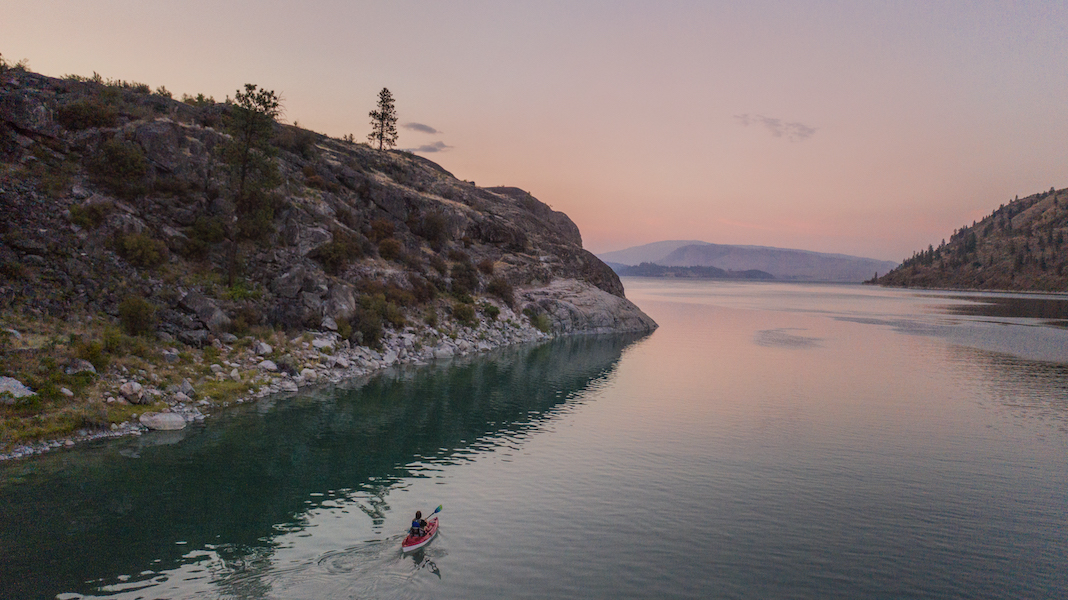
Eddyline kayak reviews
Paddling Magazine is your best online resource for Eddyline kayak reviews. Remember, the first step in choosing a kayak is considering the type of paddling you aspire to do. Reading expert reviews will allow you to evaluate how each kayak handles and how it performs for the intended paddler and conditions.












